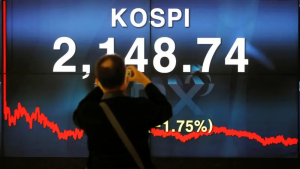U.S. stock futures climbed higher Thursday, boosted by solid results from a couple of the major tech giants. Meta Platforms and Microsoft. The Bank of Japan kept interest rates unchanged, while acknowledging future growth risks from the uncertain trade outlook. Crude continues to head lower, while Elon Musk’s position at Tesla is brought into question.
1. U.S. futures rise on Big Tech growth U.S. stock futures rose strongly Thursday, boosted by healthy earnings from a couple of the Big Tech giants, Meta Platforms (NASDAQ:META) and Microsoft (NASDAQ:MSFT).
At 03:40 ET (07:40 GMT), the S&P 500 futures traded 195 points, or 0.5%, higher Nasdaq 100 futures had risen by 55 points, or 1%, and Dow futures had gained 300 points, or 1.5%.
In the previous session on Wednesday, the S&P 500 and the Dow Jones Industrial Average closed higher, rebounding from earlier losses after data showed U.S. gross domestic product fell at an annualized pace of 0.3% - the first quarter of negative growth since the first quarter of 2022.
Wednesday marked the final trading day in April, a volatile month driven by President Donald Trump’s tariff announcements. This resulted in the S&P 500 and the DJIA recording a losing month, while the Nasdaq Composite advanced in the period.
There are more corporate earnings to digest Thursday, including from CVS Health (NYSE:CVS), Eli Lilly (NYSE:LLY) and McDonald’s (NYSE:MCD) before the open, followed by Apple (NASDAQ:AAPL) and Amazon (NASDAQ:AMZN) in the afternoon.
3rd party Ad. Not an offer or recommendation by Investing.com. See disclosure here or remove ads. On the economic data front, weekly jobless claims data will be studied ahead of Friday’s key nonfarm payrolls report.
2. Meta, Microsoft soar on strong AI-fueled demand Investors received some positive news overnight, with tech giants Meta Platforms and Microsoft offering up strong quarterly results, even amid the uncertainty surrounding the volatile global trade picture.
Meta Platforms reported better-than-expected first-quarter results and upbeat guidance that pointed to increased spending on artificial intelligence, cooling fears about slowing AI demand.
Meta’s massive user base makes it a reliable go-to for advertisers, but the Facebook and Instagram parent’s finance chief Susan Li still said that “Asia-based e-commerce exporters” have reduced their spending in reaction to President Donald Trump’s tough trade policy.
Microsoft also reported better-than-expected fiscal third-quarter results, and issued surprisingly strong guidance, as its key cloud business continued to ride AI-fueled demand.
Azure, Microsoft’s cloud business grew 33% in the quarter from a year earlier, beating analyst estimates of 30.3%, with AI making up 16% of the overall Azure growth.
Signs that AI is increasingly playing an important role in Azure’s growth comes just as many had feared that Microsoft‘s recent plans to scale back investment data centers pointed to weaker AI demand.
The share prices of both companies rose strongly in premarket trade Thursday.
There are more earnings due from the the “megacap” tech sector Thursday, with both Apple (NASDAQ:AAPL) and Amazon (NASDAQ:AMZN) due to release their quarterly results after the close.
3rd party Ad. Not an offer or recommendation by Investing.com. See disclosure here or remove ads. 3. Is change under way at Tesla? The Wall Street Journal reported late Wednesday that Tesla’s board of directors had started searching for a new CEO earlier this year amid concerns over Elon Musk’s government activities and a sharp slump in its stock price.
Board members had reached out to several executive search firms to work on a formal process to find a new CEO, the WSJ report said, citing people familiar with the discussions.
This report was subsequently denied by Tesla (NASDAQ:TSLA) Chair Robyn Denholm earlier Thursday, who added that the board is highly confident in Musk’s ability to continue "executing on the exciting growth plan ahead".
That said, the electric vehicle giant has been grappling with a difficult 2025, as its sales tumbled in the face of increased competition, dwindling EV demand, and more difficult for Musk, a sales boycott in the U.S. and Europe over the Tesla CEO’s political affiliations.
4. BOJ keeps rates steady, cuts growth forecast The Bank of Japan kept interest rates steady once more earlier Thursday, but sharply cut its growth forecast amid heightened uncertainty over U.S. President Donald Trump’s trade and economic agenda.
The BOJ left its benchmark policy rate at 0.5% as expected, for a second consecutive meeting, following a 25 basis point hike in January.
However, the policymakers warned that Japan’s economic growth was “likely to moderate” amid a slowdown in overseas economies due to trade headwinds.
The Japanese central bank slashed its gross domestic product forecast for fiscal 2025 to growth of 0.4% from 0.6%, well below its January forecast of 0.9% to 1.1%.
The policymakers also cut their 2025 core consumer price index inflation forecast to a range of 2.0% to 2.3% from a prior forecast of 2.2% to 2.6%, warning that it now saw a slower path towards inflation sustainably meeting its 2% annual target.
The BOJ’s cautious tone comes amid heightened global economic uncertainty in the face of steep U.S. trade tariffs, which were announced by Trump earlier this year.
5. More crude weakness Oil prices fell further Thursday, after the week’s selloff on concerns of weakening demand following the contraction of the U.S. economy as well as the potential for increased supply.
At 03:40 ET, Brent futures dropped 0.9% to $60.50 a barrel, and U.S. West Texas Intermediate crude futures slipped 1.1% to $57.60 a barrel.
Trading volumes were muted on account of Labor Day holidays across the globe, but both benchmarks are trading around 7% lower this week.
Sentiment has been hit hard by data showing the U.S. economy, the largest in the world and the biggest consumer of energy, contracted in the first quarter, largely linked to uncertainty over Trump’s trade and economic agenda,
And this data stream was yet to reflect the full impact of Trump’s steep trade tariffs - especially a 145% duty on China.
On the supply side, the Organization of Petroleum Exporting Countries and allies, known as OPEC+, is set to meet early next week to decide a June output plan.
Reuters reported that Saudi Arabia, the de facto leader of the group, is unwilling to prop up the oil market with supply cuts, suggesting that the cartel will accelerate output hikes in June for a second consecutive month.











